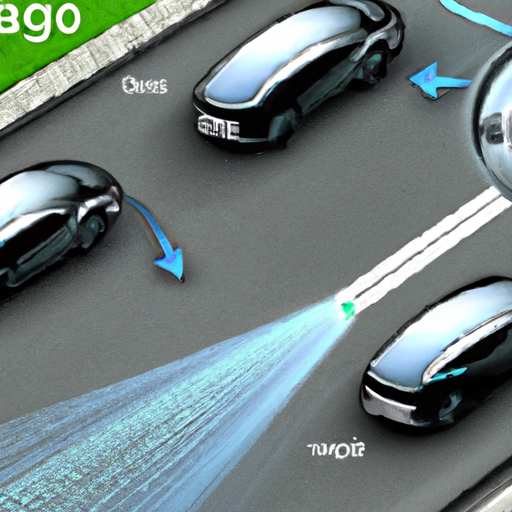Imagine this scenario: you’re backing out of a tight parking spot, trying to avoid scraping your beloved car. That’s when you realize that you have the assistance of a backup camera – but not just any ordinary one. This camera goes a step further, either providing a projected path or dynamic gridlines to guide you. In this article, we will explore the differences between these two features and help you decide which one is best suited for your needs. Get ready to make parking a breeze!

Overview of Backup Camera Technology
Backup camera technology has brought about a significant improvement in vehicle safety by providing drivers with a clear and unobstructed view of the rear of their vehicles. This technology has become increasingly popular and is now a standard feature in many new vehicles. The main purpose of a backup camera is to assist drivers in avoiding accidents and ensuring safe maneuverability while reversing, especially in tight spaces.
Components and Purpose
A backup camera system typically consists of a camera, a display unit, and various sensors. The camera is usually mounted on the rear of the vehicle, capturing a wide-angle view of the area behind it. The captured video feed is then transmitted to a display unit located inside the vehicle, allowing the driver to visualize the rear view in real-time. The sensors detect obstacles, proximity, and the vehicle’s trajectory, providing relevant information to the driver.
The primary purpose of a backup camera system is to eliminate blind spots and reduce the risk of accidents while reversing. By providing a clear view of the rear, drivers can accurately assess their surroundings and safely navigate without relying solely on their mirrors or turning around. Additionally, backup cameras can aid in parking and parallel parking, making it easier for drivers to gauge the distance from other objects or vehicles.
Evolution of Backup Camera Systems
Backup camera technology has come a long way since its inception. Initially, backup cameras were seen as a luxury feature, limited to high-end vehicles. However, with advancements in technology and increasing demand for enhanced safety features, backup cameras have become more accessible and are now widely available in vehicles across various price ranges.
Earlier backup camera systems had lower resolution displays and restricted viewing angles. However, as technology progressed, backup cameras now feature high-resolution displays with wider viewing angles, providing a much clearer and comprehensive view of the rear surroundings. Furthermore, backup camera systems have evolved to incorporate additional features such as projected path and dynamic gridlines, further enhancing their functionality and usefulness.
Backup Camera with Projected Path
A backup camera with a projected path is an advanced feature that takes backup camera technology to the next level. This feature uses the inputs from sensors and the vehicle’s trajectory to project a virtual path on the display unit, guiding the driver in the exact path the vehicle will take while reversing. This projected path assists the driver in maneuvering safely and accurately, especially in tight spaces where precision is crucial.
In addition to the projected path, backup cameras with this feature often include visual cues such as color-coded lines or arrows to indicate the direction of the vehicle’s movement. This additional visual aid makes it even easier for drivers to understand the vehicle’s trajectory and minimize the risk of collision with obstacles.

Benefits of Using Backup Camera with Projected Path
The inclusion of a projected path in a backup camera system offers several significant benefits. Firstly, it provides drivers with a higher level of precision and control while reversing, making it easier to park in tight spaces or navigate through crowded areas. The projected path acts as a guide, ensuring that the driver is aware of the vehicle’s trajectory and can adjust their steering accordingly.
Moreover, backup cameras with projected path reduce the chances of misjudging distances, particularly when maneuvering in narrow alleys or parking garages. The visual cues provided by the projected path allow drivers to accurately gauge the amount of space available and minimize the risk of colliding with walls, curbs, or other vehicles.
Furthermore, backup cameras with projected path can be particularly helpful for individuals with limited mobility or visibility impairments. The clear visual representation of the vehicle’s path enhances their confidence and enables them to reverse safely and independently, reducing the reliance on assistance from others.
Dynamic Gridlines
Dynamic gridlines are another innovative feature found in some backup camera systems. Rather than displaying a simple static image, dynamic gridlines overlay a virtual grid on the display unit that adjusts in real-time based on the steering input and vehicle’s movement. This dynamic grid provides a more accurate representation of the vehicle’s orientation and path, aiding the driver in making precise adjustments while reversing.
The dynamic gridlines typically consist of horizontal and vertical lines that correlate to the vehicle’s dimensions. As the driver turns the steering wheel, the gridlines adapt accordingly, showing the predicted path of the vehicle and its proximity to surrounding obstacles. This feature is especially useful when navigating in congested areas, where a clear understanding of the vehicle’s positioning is crucial.

Advantages of Dynamic Gridlines in Backup Cameras
The dynamic gridlines feature offers several advantages to drivers. Firstly, it enhances spatial awareness, allowing drivers to visualize the rear space and accurately determine the distance from objects or other vehicles. By providing an intuitive representation of the vehicle’s trajectory, drivers can avoid potential collisions and navigate tight spaces with ease.
Additionally, dynamic gridlines are particularly helpful for aligning the vehicle with parking spaces or parallel parking. The real-time adjustments of the gridlines enable drivers to position their vehicle precisely within the designated area, reducing the chance of misalignment or bumping into neighboring vehicles.
Another advantage of dynamic gridlines is their ability to assist in tasks such as hitching a trailer or attaching a towbar. The gridlines can be customized to align with the dimensions and specifications of the trailer or towbar, making the hitching process much more manageable and accurate.
Comparison of Backup Camera with Projected Path and Dynamic Gridlines
Although both backup camera systems with projected path and dynamic gridlines serve the same purpose of enhancing safety and maneuverability while reversing, they differ in their functionalities and approach.
A backup camera with projected path primarily focuses on providing a visual representation of the exact path the vehicle will take while reversing. By projecting a virtual path on the display unit, drivers can follow the path accurately and maneuver with precision. This feature is particularly useful in situations where accurate positioning is required, such as parking in narrow spaces or reversing alongside obstacles.
On the other hand, dynamic gridlines offer a more comprehensive visual representation of the vehicle’s orientation and surroundings. By overlaying a virtual grid that adjusts in real-time, drivers can assess the trajectory, distance, and alignment of their vehicle. This feature excels in situations where spatial awareness is crucial, such as navigating congested areas or aligning the vehicle with parking spaces.
Both features have their advantages and may be more suitable depending on the specific needs and preferences of drivers. Those who prioritize precise path guidance may prefer a backup camera with projected path, while others who value a comprehensive view of their surroundings may choose a system with dynamic gridlines.

Effectiveness in Various Situations
The effectiveness of backup cameras with projected path and dynamic gridlines can vary based on the specific situations in which they are used.
In tight parking spaces, where precise maneuverability is essential, backup cameras with projected path shine. The projected path provides drivers with an accurate representation of their vehicle’s trajectory, ensuring that they can navigate within the confined space without any hiccups. The visual cues and color-coded lines further assist drivers in making the necessary adjustments while reversing.
Dynamic gridlines, on the other hand, excel in various scenarios where spatial awareness is crucial. For example, when driving through crowded areas or backing up near pedestrians or bicyclists, the dynamic gridlines help drivers determine the proximity of their vehicle to surrounding objects, allowing them to exercise caution and prevent accidents.
Additionally, dynamic gridlines are beneficial when parallel parking or aligning the vehicle with parking spaces. The ability to observe the position and alignment of the vehicle in real-time through the gridlines enables drivers to make precise adjustments, ensuring an accurate and efficient parking process.
It is essential to consider individual driving preferences and the specific requirements of each situation when choosing between backup cameras with projected path and dynamic gridlines.
